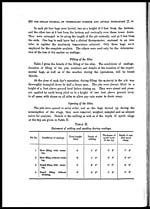Medicine - Veterinary > Veterinary colleges and laboratories > Indian journal of veterinary science and animal husbandry > Volume 1, 1931 > Part IV (December 1931) > Silage investigations at Bangalore: quality and yield of silage in relation to filling conditions
(308) Page 261
Download files
Individual page:
Thumbnail gallery: Grid view | List view

SILAGE INVESTIGATIONS AT BANGALORE 261
In all the pits considerable settling has taken place, the effect being most
marked in Nos. 3 and 4—the rapidly filled ones—and even here, No. 4 shows a
greater shrinkage than No. 3. The large shrinkage in these two pits is no doubt
due to the want of pressure, as they were filled in a few hours and therefore could
not be consolidated to the required extent. But the fact that watering helped
consolidation greatly is shown by the lower shrinkage in No. 3, than in No. 4.
This is repeated in the case of Nos. 1 and 2 respectively. But, as these were filled
only slowly, the operation extending over a week, the bottom layers had already
settled down well, and the main subsidence probably took place only in the top
third of the material.
In all the pits there was a layer of rotten, mouldy silage, at the top and sides
which had to be rejected. The thickness of the top layer varied, as will be seen
from Table II. The depth of spoilt material at the sides was small, being about
2" in all cases. Evidently Nos. 3 and 4 contained more air due to the insufficient
packing, which collected at the top when the mass settled down, and hence a
greater loss was noticed. This is reduced by slow filling as is seen from the loss in
pits 1 and 2.
The very extensive spoiling noted in No. 4 pit needs a special word of explana-
tion. This pit was not watered, and a dry silage was aimed at. But, as will be
shown later (Table VII—Loss of dry matter), the moisture content of the silage of
this pit was very high. There is no doubt that this pit was flooded by rain which
fell two days after filling. It does not represent what it was intended to, but is
of interest as a flooded pit, and the data obtained from it must be considered in
this light. The entry of the large bulk of water in the rapidly fermenting material
at the top, containing a large amount of air as well, has accentuated the loss
enormously, with the result that the depth of spoilt material constitutes a very
large proportion, roughly a third, of the entire contents of the silo.
Quality of the Silage produced.
It is of interest to note that the types of silage formed in all the pits were
much alike. They may be defined as " Brown " silage of a slightly " Acid " nature.
The products in pits 1 and 2 were distinctly less acid, and those in Nos. 1 and 3
had a slightly more pleasant odour than the rest. The product of pit No. 4, though
acid, had not the good aroma of the others, thus showing the effects of the leach-
ing down of the spoilt material from the top layers.
As a general conclusion, watering gives the silage a better aroma, and slow
filling, a lower acidity.
B 2
Set display mode to: Large image | Zoom image | Transcription
Images and transcriptions on this page, including medium image downloads, may be used under the Creative Commons Attribution 4.0 International Licence unless otherwise stated. ![]()
| Permanent URL | https://digital.nls.uk/75226719 |
|---|
| Description | Covers articles from 1931. |
|---|




